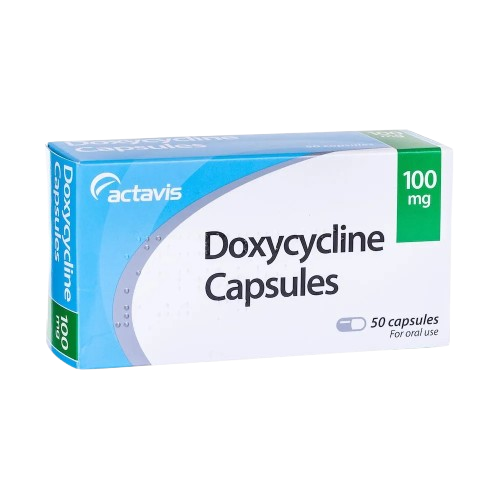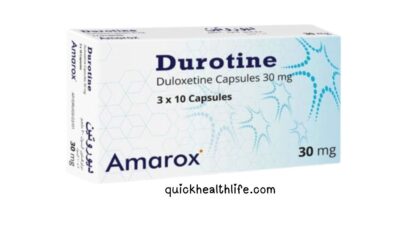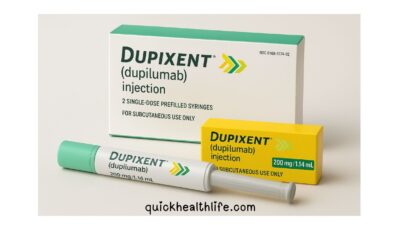What is Doxycycline?
Doxycycline is an oral antibiotic available in different formulations, including doxycycline tablet and doxycycline capsule. It is a semi-synthetic derivative of tetracycline with superior absorption and longer duration of action. Unlike some other antibiotics, it can be taken with or without food, though certain precautions enhance its effectiveness.
Available Formulations
- Doxycycline hyclate (most common)
- Doxycycline monohydrate
- Capsules (100mg, 50mg)
- Tablets (100mg, 75mg, 50mg)
- Oral suspension
- Intravenous formulation
Table of Contents
Doxycycline Uses
The range of conditions treated with doxycycline is extensive. Some common and important doxycycline 100mg uses include:
- Respiratory tract infections – bronchitis, pneumonia, and sinusitis.
- Skin conditions – acne vulgaris, rosacea, and skin infections caused by Staphylococcus aureus.
- Sexually transmitted infections (STIs) – including chlamydia, gonorrhea (in combination therapy), and syphilis in specific cases.
- Urinary tract infections (UTIs) – though less frequently the first choice, it may be used depending on resistance patterns.
- Periodontal (gum) disease – particularly as an adjunct in dental infections.
- Malaria prevention and treatment – especially for travelers visiting regions with drug-resistant strains.
- Zoonotic infections – such as Lyme disease, anthrax, tularemia, and leptospirosis.
For veterinary purposes, the answer to what is doxycycline used for in dogs? is quite varied—it treats tick-borne diseases like ehrlichiosis, heartworm disease, and respiratory infections in animals.
Doxycycline Dosage Guide
| Condition | Typical Adult Dosage | Duration |
|---|---|---|
| Bacterial infections | 100mg twice daily first day, then 100mg daily | 7-14 days |
| Acne treatment | 50-100mg daily | Several months |
| Malaria prevention | 100mg daily | Start 1-2 days before travel, continue 4 weeks after |
| Lyme disease | 100mg twice daily | 10-21 days |
| Chlamydia | 100mg twice daily | 7 days |
Important dosing instructions:
- Take with a full glass of water
- Remain upright for at least 30 minutes after taking
- Avoid taking within 2-3 hours of dairy, antacids, or iron supplements
Doxycycline Side Effects
Common Side Effects (Usually Mild)
- Nausea, vomiting, or diarrhea
- Sun sensitivity (easier sunburn)
- Mild skin rash or itching
- Vaginal yeast infection (in women)
- Esophageal irritation (if not taken with enough water)
Serious Side Effects (Require Medical Attention)
- Severe headache or vision changes (signs of intracranial hypertension)
- Severe skin reactions
- Difficulty swallowing or painful swallowing
- Yellowing skin or eyes (liver problems)
- Unusual bleeding or bruising
Warnings and Precautions
Who Should Avoid Doxycycline?
- Pregnant women (may affect fetal bone and tooth development)
- Children under 8 years (can cause permanent tooth discoloration)
- People with history of intracranial hypertension
- Those with severe liver impairment
Special Considerations
- Breastfeeding: Small amounts pass into breast milk; use only if clearly needed
- Sun exposure: Use sunscreen and protective clothing
- Drug interactions: Many possible interactions (see below)
Drug Interactions Table
| Medication Type | Interaction Effect | Recommendation |
|---|---|---|
| Antacids | Reduced absorption | Separate by 2-3 hours |
| Calcium supplements | Reduced effectiveness | Take at different times |
| Blood thinners (warfarin) | Increased bleeding risk | Monitor clotting levels |
| Birth control pills | Possible reduced effectiveness | Use backup method |
| Antiseizure medications | Reduced antibiotic levels | May need dosage adjustment |
| Alcohol | May decrease effectiveness | Avoid excessive consumption |
Doxycycline Hyclate
A commonly prescribed form, doxycycline hyclate, is often preferred due to its high oral absorption and effectiveness. It is available as both doxycycline tablet and doxycycline capsule 100mg, used in the same conditions as other formulations but may differ slightly in tolerability.
FAQ About doxycycline
Q: Can I drink alcohol while taking doxycycline?
A: While not absolutely prohibited, alcohol may reduce the effectiveness of doxycycline and increase the risk of side effects like stomach upset. Moderate consumption is generally acceptable but discuss with your doctor.
Q: How long does it take for doxycycline to work for acne?
A: Most people see improvement in 6-8 weeks, but maximum benefits may take 12 weeks or longer. Consistent use is important for acne treatment.
Q: What should I do if I miss a dose?
A: Take it as soon as you remember, unless it’s almost time for your next dose. Never double the dose to make up for a missed one.
Q: Why can’t I lie down after taking doxycycline?
A: Remaining upright for at least 30 minutes helps prevent the medication from irritating your esophagus, which can cause painful inflammation or ulcers.



